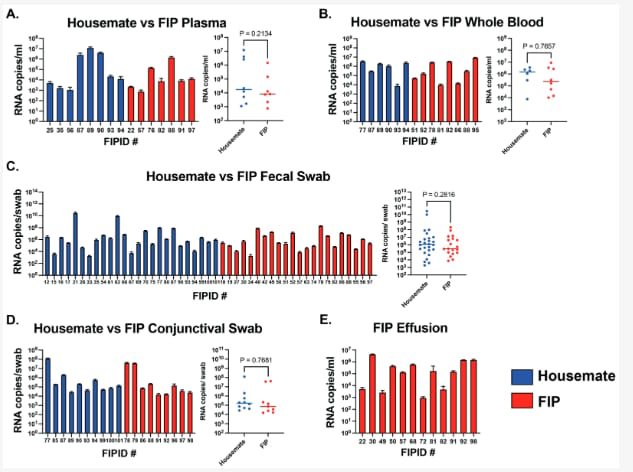- Veterinary View Box
- Posts
- Feline Coronavirus RNA: FIP Cats Shed as Much Virus as Healthy Housemates, Study Finds
Feline Coronavirus RNA: FIP Cats Shed as Much Virus as Healthy Housemates, Study Finds
Viruses 2025
Phoenix M. Shepherd, Amy Elbe, Brianna M. Lynch, Erin Lashnits, Robert N. Kirchdoerfer
Background
Feline coronavirus (FCoV) can cause a range of outcomes in cats, from asymptomatic infection to the fatal condition feline infectious peritonitis (FIP). The mechanisms determining progression to FIP remain unclear. It has been hypothesized that FIP arises from mutations in a pre-existing enteric FCoV within the same cat, rather than direct transmission of an FIP-associated strain. However, the distribution and quantity of viral RNA across different tissues in naturally infected cats—and whether these patterns differ between cats with FIP and their housemates—are poorly understood.
Methods
The study enrolled 75 cats: 36 with suspected FIP, 39 housemates, and 9 unexposed controls. Blood (whole and plasma), fecal, conjunctival, and effusion samples were collected. A highly sensitive two-step, dual-quenched TaqMan RT-qPCR assay targeting a conserved region of the FCoV genome was used to quantify viral RNA. The assay’s specificity was evaluated against related coronaviruses (canine and porcine respiratory coronaviruses). Statistical analyses compared viral RNA quantities between FIP and non-FIP cats, matched housemates, sexes, and ages.
Results
-Specificity: Assay could cross-react with canine and porcine respiratory coronaviruses but no evidence of these infections in study cats.
-Plasma & Whole Blood: Low detection rates; no significant differences between FIP and non-FIP cats.
-Fecal Swabs: High positivity (~74% in both groups) and highest RNA levels among sample types; no significant group differences.
-Conjunctival Swabs: Detectable viral RNA in ~65–71% of both groups; no significant differences.
-Effusions: High viral RNA levels in 75% of wet-FIP cats.
-Household Analysis: No consistent pattern of higher viral load in FIP cats compared to housemates.
-Demographics: No sex-related differences; quantifiable viral RNA more common in younger cats.
Limitations
-Lack of definitive FIP diagnosis for all cases; diagnosis was based on clinical suspicion.
-Unknown infection histories and variable sampling times between FIP cats and housemates.
-Assay cannot distinguish between actively replicating virus and residual RNA.
-Potential but unconfirmed cross-reactivity with related coronaviruses.
Conclusions
The presence and quantity of FCoV RNA in blood, feces, conjunctiva, and effusion do not distinguish cats with FIP from their healthy housemates. Both groups can shed similar amounts of virus, particularly in feces. These findings suggest that factors beyond viral load—such as viral genetic changes or immune interactions—may drive FIP development. The dual-quenched RT-qPCR assay provides a sensitive tool for detecting FCoV RNA across sample types, but further genomic and immunological studies are needed to elucidate FIP pathogenesis.

Quantifiable RT-qPCR data as RNA copies/mL or RNA copies/swab in each sample type for each FIP identification number (FIPID #): (A) plasma; (B) whole blood; (C) fecal swabs; (D) conjunctival swabs; and (E) effusion. Samples that were detected but not quantifiable or were below the limit of detection are not shown. Unpaired t-test results are displayed as p-values. Statistical significance was defined as p < 0.05.
How did we do? |
Disclaimer: The summary generated in this email was created by an AI large language model. Therefore errors may occur. Reading the article is the best way to understand the scholarly work. The figure presented here remains the property of the publisher or author and subject to the applicable copyright agreement. It is reproduced here as an educational work. If you have any questions or concerns about the work presented here, reply to this email.